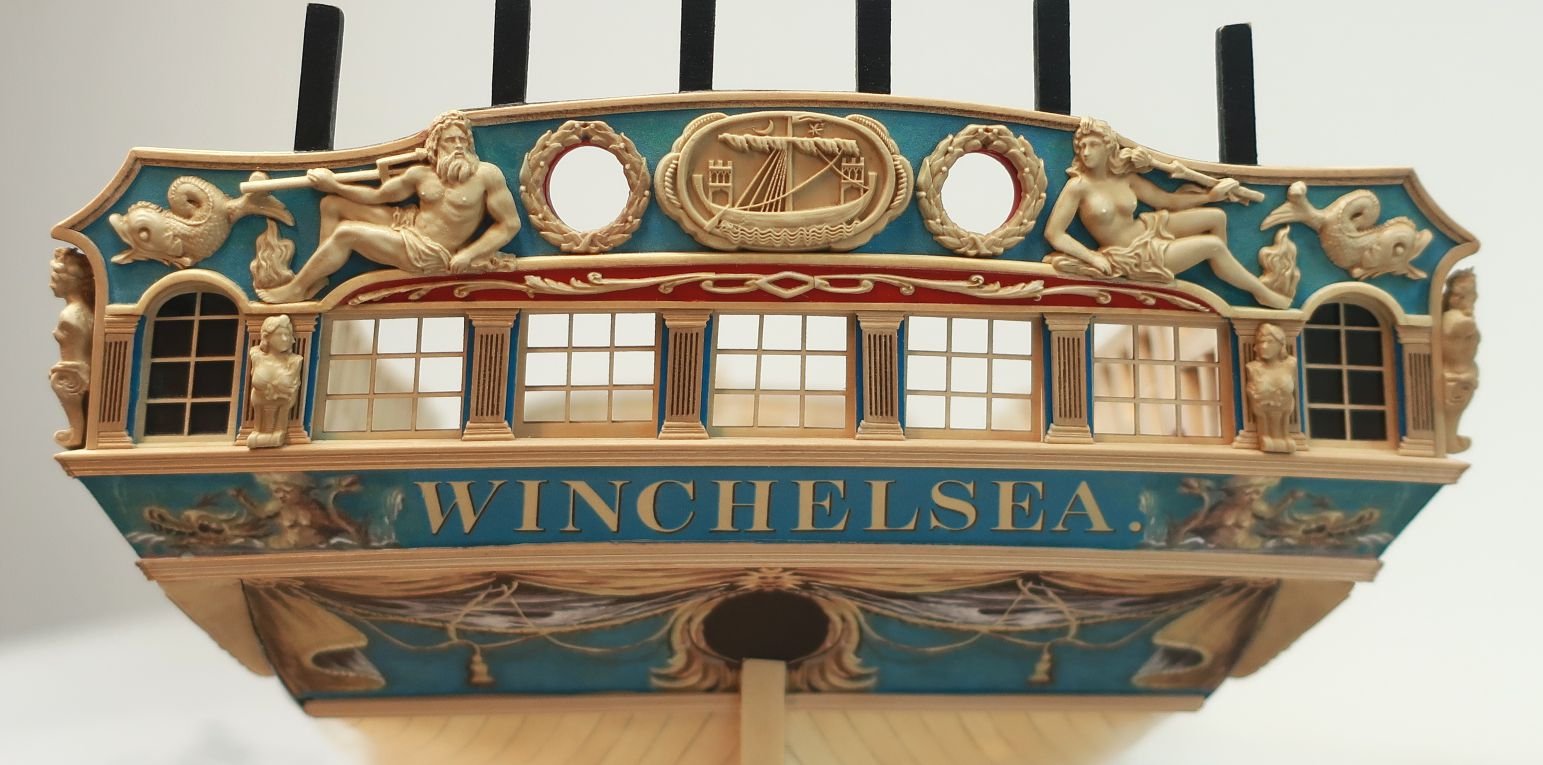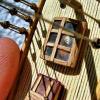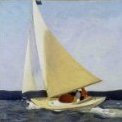-
Posts
9,065 -
Joined
-
Last visited
Reputation Activity
-
 Chuck reacted to SkerryAmp in Mayflower by SkerryAmp - Model Shipways - 5/32" = 1'
Chuck reacted to SkerryAmp in Mayflower by SkerryAmp - Model Shipways - 5/32" = 1'
Well, nothing HUGE... but a quick update. My plan as mentioned before was to get the other trim up over the weekend, well - when I went to do that I noticed a tiny tiny flaw in my ship which I had to rectify ASAP. One of the railings wasn't trimmed and sanded properly and was thicker than the other so had to work on that a bit before anything else could happen.
Then, of course tonight I realized I couldn't just lay the trim down either as it would be easier to take care of some of the painting first.
So - tonights up date, the yellow painting along the exterior of the forward and rear decks. This of course has to dry and then tomorrow will be masking it off and doing the green stripes. THEN adding the trim!
Whew!
So, here it is, the mayflower + yellow paint!
I searched around for a yellow that I thought looked real good, and one of the threads here had mentioned using artist acrylics. So, poked around: the goal was to look for the right colors but more subdued and less vibrant than a lot of the model acrylics tend to come in. Whalla! Yellow Ochre. I used Winsor and Newton Galeria artist acrylics, and while straight from the tube they worked well I did use a little liquitex flow aid to help even out the finish a bit.
Here is the result
I wasn't overly concerned with "neatness" at this point (I mean I didn't just slap the paint on but wasn't dialed into final lines etc) as there will be trim over the edges as well as masked and repainted secondary edges which is where I will start to hone in and focus on the lines.
Until next time!!
Enjoy!
-
 Chuck got a reaction from flying_dutchman2 in Curious about Amati ropewalk
Chuck got a reaction from flying_dutchman2 in Curious about Amati ropewalk
Dont be so quick to say its crap....I basically use it to produce all of my rope for Syren Ship Model company. With a modification or two....you can lay up a 21 foot length of rope in about 8 minutes. I have demonstrated this at my local club. I make approximately 5-6000 feet of rope on that so-called piece of crap every month. You can buy them for 20 bucks and when it gets used up...throw it away and get another. The average builder will never need to make 70,000 feet of rope per year so it will last a lifetime. In my case...I used one for three years....so I recommend them highly. I use a variable speed drill to power each end. The principle of making rope is very simple...I subscribe to the KISS philosophy. Why over complicate things. It does the job nicely. But if you want to spend a lot more.....on ...other machines...thats OK too. I just decided yesterday to retire my current ropewalk and built another in 30 minutes. I am good to go for another 100,000 feet of rope at least. The one I use is the Model shipways version but they are identical in every respect. The exact same design and parts.
I think my rope is the best on the market today so if its any indication.....
-
 Chuck got a reaction from SkerryAmp in Mayflower by SkerryAmp - Model Shipways - 5/32" = 1'
Chuck got a reaction from SkerryAmp in Mayflower by SkerryAmp - Model Shipways - 5/32" = 1'
Thats for the rigging. see the rigging plan for that....there should be another small drawing showing how that is used also...
Chuck
-
 Chuck got a reaction from robnbill in Staining Blocks
Chuck got a reaction from robnbill in Staining Blocks
Thats rather messy. I choose to place a few dozen on a some paper towels and then dip another in the stain. Then roll them around with it. It gets just the right amount on them without clogging the sheave holes.
Chuck
-

-
 Chuck got a reaction from WackoWolf in 21ft English Pinnace by Mike Y - FINISHED - Model Shipways - 1:24
Chuck got a reaction from WackoWolf in 21ft English Pinnace by Mike Y - FINISHED - Model Shipways - 1:24
Well done sir!!!
Those are just some stands for the hull. If you glue them to a scrap board it will keep your hull upright so you can work on the interior details. I found myself just holding the hull in my hands most of the time but I figured what the heck....why not throw them in there anyway.
You did a really nice job sanding down the interior frames. There area few details I omitted from the kit but if you are up to the challenge I can explain what they are.
Under each seat in the cockpit there should be a panelled support...but that is a really experienced little doo-dad on each side to build. they couldnt be laser cut because there are too many variables depending on how well the inside was sanded down and where the risers were placed. So I just left them out of the kit for simplicity. But if you are up to it...give it a shot. see this image for an example. But not all small pinnaces had them. In fact the small pinnace the kit was based on did not have one as you can see by the second photo below. This first photo is a larger more impressive Admirals Barge. But some smaller pinnaces did have the panels under those seats as well.
In addition...On the fore side of the seat back there should be a panel as well. Again this would be quite a challenge to make the fancy molding for and keep it thin so it doesnt look bulky. I decided to leave the feature off the pinnace kit for simplicity as well. Once again it could not be laser cut because there are too many variables. The depth of the seatback and the width would change for every model built depending on how well the interior was sanded and where the risers were placed. It is also difficult to bend the top of the panel if it wasnt laser cut. This is another challenge I have yet to see anyone add to the model. Note that the panel outline is let-into the seatback.
See below.
The last detail I omitted was the long boards down the center of the hull between the thwarts. They only appear between the two aft-most thwarts. They are also let-in to each thwart which could get tricky for some folks.
Also note how thin and elegant the cap rail is. If you can get the tops of the frames inboard sanded down even thinner you may be able to achieve the same results. Most often they are left too thick and it begins to look very clunky and heavy. But yes....the hull is very light but surprisingly strong at this point so dont be afraid to try it. Once the panels and thwarts are in position the whole thing gets really rigid and strong. Just be careful with it until then.
Thats it for the stuff I omitted but they remain optional at any rate.
Chuck
-
 Chuck got a reaction from fnkershner in 18th century Longboat by fnkershner (Floyd Kershner) - Model Shipways - 1:48
Chuck got a reaction from fnkershner in 18th century Longboat by fnkershner (Floyd Kershner) - Model Shipways - 1:48
Good luck and i am eagerly awaiting some progress reports. Here are the answers to your questions.....
The Basswood sheet that contains the bulkheads is 3/32 of an inch thick. Also on this sheet are the 2 lengths for the keel & 2 rudders. is this just extras or are we intended to glue then together to get a thickness of 3/16? The same occurs on the sheet with the Stem. I have 2 stems.
Just extras...I had the room so why not add them just in case...shhhh dont let Expo know!!!
Next question, On the 3/32 sheet with the stem there are 2 small pieces which I believe are the stern post. Again is the intent to glue them together to get more thickness. Finally there are 3 bow blocks on this sheet. I can figure out what to do with 2 bow blocks but is the 3rd one extra?
All just extras....
A final comment, since Jeff is backed up supplying all of us builders with wood. This log may move a bit slow for the next couple of months. I started it now because this is a great opportunity to gather info from those who have gone before me. I also felt this was the best way to ask questions without cluttering someone else's build.
Note: Just use some wipe on poly on all the basswood frames which will match the boxwood nicely. Sand both sides of the board with teh bulkheads with very fine sandpaper to get a smooth finish BEFORE you remove them each from the sheet and to also remove the laser char. Then give them several coats of wipe on poly.....leave the laser cut edges alone though.....dont sand those too much at all until you have to fair the hull. Hope that makes sense.
Enjoy the project.
Chuck
-
 Chuck got a reaction from fnkershner in 21ft English Pinnace by Mike Y - FINISHED - Model Shipways - 1:24
Chuck got a reaction from fnkershner in 21ft English Pinnace by Mike Y - FINISHED - Model Shipways - 1:24
Well done sir!!!
Those are just some stands for the hull. If you glue them to a scrap board it will keep your hull upright so you can work on the interior details. I found myself just holding the hull in my hands most of the time but I figured what the heck....why not throw them in there anyway.
You did a really nice job sanding down the interior frames. There area few details I omitted from the kit but if you are up to the challenge I can explain what they are.
Under each seat in the cockpit there should be a panelled support...but that is a really experienced little doo-dad on each side to build. they couldnt be laser cut because there are too many variables depending on how well the inside was sanded down and where the risers were placed. So I just left them out of the kit for simplicity. But if you are up to it...give it a shot. see this image for an example. But not all small pinnaces had them. In fact the small pinnace the kit was based on did not have one as you can see by the second photo below. This first photo is a larger more impressive Admirals Barge. But some smaller pinnaces did have the panels under those seats as well.
In addition...On the fore side of the seat back there should be a panel as well. Again this would be quite a challenge to make the fancy molding for and keep it thin so it doesnt look bulky. I decided to leave the feature off the pinnace kit for simplicity as well. Once again it could not be laser cut because there are too many variables. The depth of the seatback and the width would change for every model built depending on how well the interior was sanded and where the risers were placed. It is also difficult to bend the top of the panel if it wasnt laser cut. This is another challenge I have yet to see anyone add to the model. Note that the panel outline is let-into the seatback.
See below.
The last detail I omitted was the long boards down the center of the hull between the thwarts. They only appear between the two aft-most thwarts. They are also let-in to each thwart which could get tricky for some folks.
Also note how thin and elegant the cap rail is. If you can get the tops of the frames inboard sanded down even thinner you may be able to achieve the same results. Most often they are left too thick and it begins to look very clunky and heavy. But yes....the hull is very light but surprisingly strong at this point so dont be afraid to try it. Once the panels and thwarts are in position the whole thing gets really rigid and strong. Just be careful with it until then.
Thats it for the stuff I omitted but they remain optional at any rate.
Chuck
-
 Chuck got a reaction from WackoWolf in USf Confederacy by oldpaperone - Model Shipways - now in Australia
Chuck got a reaction from WackoWolf in USf Confederacy by oldpaperone - Model Shipways - now in Australia
You need to remove all of that laser char before you glue them together. That is important to get a good bond. Once done....it will fit together well if you are careful. Dont forget to darken the edges with a pencil.
Too many people dont remove the laser char and they wont get a good fit at all. The laser does not produce a perfect right angle when cutting. The the joints will be larger on one side than the other because of the slight angle the laser cuts at. Once again this is important for all parts to make the edges a right angle and get a tight fit on both sides.
Enjoy the project and dont hesitate to ask me any questions.
Chuck
-
 Chuck got a reaction from fnkershner in 18th century English Longboat by Chuck - FINISHED - c.1760
Chuck got a reaction from fnkershner in 18th century English Longboat by Chuck - FINISHED - c.1760
There are many variations. This is just one example. I decided to go with a single banked longboat at only 26 ft long. This example from the NMM is much larger. But you may add more oarlocks if you like. It would not be historically inaccurate Also The way the shrouds are shown here are more accurate. They were simplified in the kit rather than use the hooked method. You will notice that most of the lines are hooked.. The hooks allow for quick demasting when the boat is to be stowed or set up for sail. I did decide to add the hooked back stays though. Rather than just tie them off at the cap rail as I thought it would look too kit-like. The rope coils on the back stays are the falls from the tackle. They are belayed to the line above the block as done on the kit. Thats why I posted these. Just in case folks want to go the whole nine yards with it. The scale makes it difficult though but it would really kick it up a notch.
Chuck
-
 Chuck got a reaction from Jonny 007 in 18th century English Longboat by Chuck - FINISHED - c.1760
Chuck got a reaction from Jonny 007 in 18th century English Longboat by Chuck - FINISHED - c.1760
With several of you folks starting to rig the longboat I figured it would be good to post these images of a rigged longboat from the NMM. And before anyone remarks how they may be copyright...I checked into the images and they are not as long as you credit the NMM.
SO....."These images are provided generously from the NMM for our educational use" and are not stored in our database. Our site is pulling the images direct from the NMM site. We are just pointing to what is already made available to the public.
Collection images must always credit ‘National Maritime Museum, Greenwich, London’ and link to the original collection record on the NMM collections website. Collections OnlineThe NMM has developed an Application Programming Interface (API) to make it easy for individuals and organisations to share its collection records and images with the public. If you need to download more than 25 images at a time, you are encouraged to use the API.
Collection images must always credit ‘National Maritime Museum, Greenwich, London’ and link to the original collection record on the NMM collections website. Do not make an unreasonable number of API calls or compromise the experience of other users. As a guide, you should make no more than 3000 calls per day and no more than one request per second. We may place more formal limits on the API in the future. The maximum allowed enlargement of images is 1200 pixels along the longest length of the image. Do note that these images are made available for non-commercial use only. Please contact the Picture Library if you would like to use the NMM’s collection records under different conditions.
Got that out of the way.
Enjoy. They show the rigging very clearly. Click on them and they are even larger.
Chuck
-
 Chuck got a reaction from fnkershner in 18th Century Longboat question?
Chuck got a reaction from fnkershner in 18th Century Longboat question?
Basically the planking....<ost folks will buy the kit because its not expensive and small and that alone doe not make it a beginner kit. But often times they think that. Planking a small boat hull like that is much harder than planking a larger hull. The bends and angles required make spiling and shaping the planking a must. This is something that beginner builders can not fudge. Yes the hull is painted but you will see see the run of the planks inboard and using such thin planking material it doesnt leave much room for sanding out errors. Filling any gaps may also be seen inboard.
Basically it is the proper planking expertise that makes it an advanced kit. Especially at the small 1/4" scale. That being said. Its a great teaching tool to learn proper planking and with only a few strakes per side they can be ripped off and done over many times. For example, My local club is building the Pinnace kit and we are using it to teach more advanced planking techniques. Some of our members have ripped off the planks three and four times.
You will learn how to properly shape a garboard strake and where to place its forward end. Dont let it scare you. Give it a try but if you have never planked a small boat like this before, you should expect some new things to pop up while doing so.
Again...read all of the logs on this site as suggested.
Chuck
-
 Chuck reacted to JPZ66 in casting metal parts including cannon
Chuck reacted to JPZ66 in casting metal parts including cannon
Hi All,
Colin answered that pretty well. The quality of the master is very important......especially in resin casting, what you see is what you get.
You choose an appropriate resin to cast with and along with well made molds ( a big key here ), you get your castings.
Metal is a bit more involved..... Typically metal castings are done on centrifugal casting machines, using vulcanized rubber molds. The caster must have a good understanding of many factors that come into play.
White Metal is a generic term. There are many formulas to be had here, depending upon the mix. Tin, Antimony, and copper are the primary metals used in this mix, and the casting properties can be affected by the ratios of each metal used. Furthermore, the purity, the temperature, the spin speed, flow distance, part orientation and plate pressure of the mold clamps can all play a part. Most casters develop their own feel for it and manage to come to workable settings for the type of casting they do. It is part science, and part experience. Play with any of those variables and you can have any number of quality issues....mis-cast, porosity, drossy or dirty parts, brittle or crystalized looking parts, etc. Get them all right and you have clean, crisp, dense and well structured parts.
Trust me, there is a learning curve to production white metal casting !
As for the finished items and how do different materials compare, if the quality of the castings are equal - be they resin, metal or some other material, well painted and detailed parts will show no difference. For the hobby modeler who wishes to make castings, I would recommend RTV silicone molds and a low odor casting polyurethane resin.
- Joe
-
 Chuck got a reaction from BANYAN in casting metal parts including cannon
Chuck got a reaction from BANYAN in casting metal parts including cannon
Personally I prefer the bottom fill method to avoid bubbles and empty cavities. Here are some pics with off-the-shelf resin/mold kit...there are plenty of techniques to learn and a tutorial would be welcome. You can send it to me and I will post it in the database of articles. The part you are looking at is only about 3/4" long if I remember correctly.
Chuck
-
 Chuck got a reaction from Leo-zd in casting metal parts including cannon
Chuck got a reaction from Leo-zd in casting metal parts including cannon
Personally I prefer the bottom fill method to avoid bubbles and empty cavities. Here are some pics with off-the-shelf resin/mold kit...there are plenty of techniques to learn and a tutorial would be welcome. You can send it to me and I will post it in the database of articles. The part you are looking at is only about 3/4" long if I remember correctly.
Chuck
-
 Chuck reacted to SkerryAmp in Mayflower by SkerryAmp - Model Shipways - 5/32" = 1'
Chuck reacted to SkerryAmp in Mayflower by SkerryAmp - Model Shipways - 5/32" = 1'
Egads! Can it be!
YES, yes it is... an update!
Que fan faire!
So, pulled out the mayflower and have prepped to fit the exterior trims, wales etc. The first two wales were bent by soaking them in some windex and clothespinning them to the rim of a glass to get a nice curve. Once dried,took them out and in they went. Surprisingly they went in pretty smooth.
I have a little touch up on the white to do where it meets the lower wale but other than that, I think they came out pretty good.
Once all the trim is on I will poly it all up nice and neat and give it a slight sheen which should deepen the colors and really bring out the ebony a bit more.
Looks like I will have some more time for a while to be at the bench so will be making the most of it as best I can!!!
Enjoy and Happy Building all!!
-
 Chuck got a reaction from WackoWolf in casting metal parts including cannon
Chuck got a reaction from WackoWolf in casting metal parts including cannon
Personally I prefer the bottom fill method to avoid bubbles and empty cavities. Here are some pics with off-the-shelf resin/mold kit...there are plenty of techniques to learn and a tutorial would be welcome. You can send it to me and I will post it in the database of articles. The part you are looking at is only about 3/4" long if I remember correctly.
Chuck
-
 Chuck got a reaction from janos in casting metal parts including cannon
Chuck got a reaction from janos in casting metal parts including cannon
Personally I prefer the bottom fill method to avoid bubbles and empty cavities. Here are some pics with off-the-shelf resin/mold kit...there are plenty of techniques to learn and a tutorial would be welcome. You can send it to me and I will post it in the database of articles. The part you are looking at is only about 3/4" long if I remember correctly.
Chuck
-
 Chuck reacted to molasses in In need of Tips and Techniques for making Eyebolts
Chuck reacted to molasses in In need of Tips and Techniques for making Eyebolts
I used the technique described by Chuck to make some ring bolts. I twisted 40 gauge (.0055 inch / 0.14mm) copper wire around .010 inch (0.25mm) piano wire to make the eye bolt. [is that "crazy small" enough for you, Chuck?] I made rings .030 inch (0.75mm) inside diameter, fished the ring into the eye, brought the ends into contact and glued them with ca transferred on the point of a needle. Here's a completed ring bolt. I made a total of twenty of them and, yes, they were very fiddly.
-
 Chuck got a reaction from Q A's Revenge in Curious about Amati ropewalk
Chuck got a reaction from Q A's Revenge in Curious about Amati ropewalk
Thanks...
Thats what I am hoping....I know there will always be folks who just dont want to bother spending the time to make rope. Regardless of what tool you use it still takes time to learn and test. If you dont plan on selling it as a business then making rope once a year for a project isnt all that appealing.
I hope...
-
 Chuck got a reaction from Jay 1 in Curious about Amati ropewalk
Chuck got a reaction from Jay 1 in Curious about Amati ropewalk
Trial and error same as always. Just keep it lubricated...I spray some WD-40 on it every day before I use it. No real tricks...no real mystery. Rope making is a simple principle. You just have to get the timing correct and tension on each side after twister. You must establish an equilibrium after twisting that gives you a nice looking rope. This will be different depending on teh size of teh rope and the material you use and the amount of threads on each eye.
Yes it looks cheasy but I wouldnt trade it for anything else. I do wish the diameter of the circular parts were larger. This would allow a forth eye on them for four stranded rope. But it works a treat. Now you know my secret...so much for my rope business now, LOl !!! I am no engineer either...look at that high tech piece of equipment... and stylish as well. A 21' length of rope in 8 minutes....try and beat that. See the pics of my rope-a-dashery below. I will be making 500 feet of brown rope today...joy!!
Chuck
-
 Chuck got a reaction from clipper in Curious about Amati ropewalk
Chuck got a reaction from clipper in Curious about Amati ropewalk
Dont be so quick to say its crap....I basically use it to produce all of my rope for Syren Ship Model company. With a modification or two....you can lay up a 21 foot length of rope in about 8 minutes. I have demonstrated this at my local club. I make approximately 5-6000 feet of rope on that so-called piece of crap every month. You can buy them for 20 bucks and when it gets used up...throw it away and get another. The average builder will never need to make 70,000 feet of rope per year so it will last a lifetime. In my case...I used one for three years....so I recommend them highly. I use a variable speed drill to power each end. The principle of making rope is very simple...I subscribe to the KISS philosophy. Why over complicate things. It does the job nicely. But if you want to spend a lot more.....on ...other machines...thats OK too. I just decided yesterday to retire my current ropewalk and built another in 30 minutes. I am good to go for another 100,000 feet of rope at least. The one I use is the Model shipways version but they are identical in every respect. The exact same design and parts.
I think my rope is the best on the market today so if its any indication.....
-
 Chuck got a reaction from mikeaidanh in Curious about Amati ropewalk
Chuck got a reaction from mikeaidanh in Curious about Amati ropewalk
Dont be so quick to say its crap....I basically use it to produce all of my rope for Syren Ship Model company. With a modification or two....you can lay up a 21 foot length of rope in about 8 minutes. I have demonstrated this at my local club. I make approximately 5-6000 feet of rope on that so-called piece of crap every month. You can buy them for 20 bucks and when it gets used up...throw it away and get another. The average builder will never need to make 70,000 feet of rope per year so it will last a lifetime. In my case...I used one for three years....so I recommend them highly. I use a variable speed drill to power each end. The principle of making rope is very simple...I subscribe to the KISS philosophy. Why over complicate things. It does the job nicely. But if you want to spend a lot more.....on ...other machines...thats OK too. I just decided yesterday to retire my current ropewalk and built another in 30 minutes. I am good to go for another 100,000 feet of rope at least. The one I use is the Model shipways version but they are identical in every respect. The exact same design and parts.
I think my rope is the best on the market today so if its any indication.....
-
 Chuck got a reaction from WackoWolf in Curious about Amati ropewalk
Chuck got a reaction from WackoWolf in Curious about Amati ropewalk
Thanks...
Thats what I am hoping....I know there will always be folks who just dont want to bother spending the time to make rope. Regardless of what tool you use it still takes time to learn and test. If you dont plan on selling it as a business then making rope once a year for a project isnt all that appealing.
I hope...
-
 Chuck got a reaction from mtaylor in Curious about Amati ropewalk
Chuck got a reaction from mtaylor in Curious about Amati ropewalk
Trial and error same as always. Just keep it lubricated...I spray some WD-40 on it every day before I use it. No real tricks...no real mystery. Rope making is a simple principle. You just have to get the timing correct and tension on each side after twister. You must establish an equilibrium after twisting that gives you a nice looking rope. This will be different depending on teh size of teh rope and the material you use and the amount of threads on each eye.
Yes it looks cheasy but I wouldnt trade it for anything else. I do wish the diameter of the circular parts were larger. This would allow a forth eye on them for four stranded rope. But it works a treat. Now you know my secret...so much for my rope business now, LOl !!! I am no engineer either...look at that high tech piece of equipment... and stylish as well. A 21' length of rope in 8 minutes....try and beat that. See the pics of my rope-a-dashery below. I will be making 500 feet of brown rope today...joy!!
Chuck
















